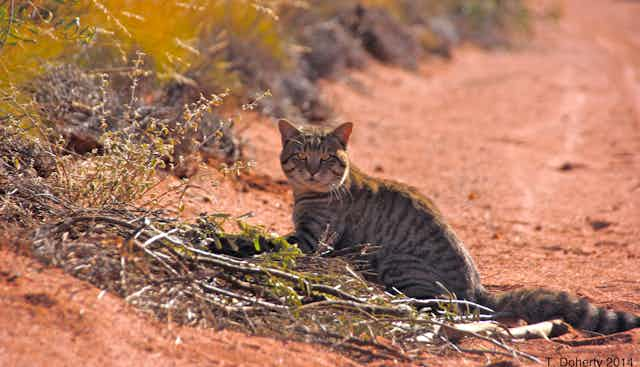Invasive species are a threat to wildlife across the globe – and invasive, predatory mammals are particularly damaging.
Our research, recently published in Proceedings of the National Academy of Sciences, shows that these predators – cats, rats and foxes, but also house mice, possums and many others – have contributed to around 60% of bird, mammal and reptile extinctions. The worst offenders are feral cats, contributing to over 60 extinctions.
So how can we stop these mammals eating away at our threatened wildlife?
Counting the cost
Our study revealed that invasive predators are implicated in 87 bird, 45 mammal and 10 reptile extinctions — 58% of these groups’ contemporary extinctions worldwide.
Invasive predators also threaten 596 species classed as vulnerable, endangered or critically endangered on the International Union for the Conservation of Nature Red List. Combined, the affected species include 400 birds, 189 mammals and 149 reptiles.
Twenty-three of the critically endangered species are classed as “possibly extinct”, so the number of extinctions above is likely to be an underestimate.
Until now, these shocking statistics have been unknown, and the heavy toll of invasive predators on native biodiversity grossly underappreciated. Species extinctions attributed to invasive predators include the Hawaiian rail (Zapornia sandwichensis) and Australia’s lesser bilby (Macrotis leucura).

Who are the worst offenders?
We found that three canids (including the red fox and feral dogs), seven members of the weasel family or mustelids (such as stoats), five rodents, two primates, two mongooses, two marsupials and nine species from other families negatively impact threatened species. Some of these species, such as hedgehogs and brushtail possums, don’t immediately spring to mind as predators, yet they are known to prey on many threatened species.
Feral cats threaten the most species overall (430), including 63 that have become extinct. This equates to one-quarter of all bird, mammal and reptile extinctions – making the feral cat arguably the most damaging invasive species for animal biodiversity worldwide.
Five species of introduced rodent collectively threaten 420 species, including 75 extinctions. While we didn’t separate out the impacts of individual rodent species, previous work shows that black rats (Rattus rattus) threaten the greatest number of species, followed by brown rats (R. norvegicus) and Pacific rats (R. exulans).
The humble house mouse (Mus musculus) is another interesting case. Despite their small size, house mice have been recorded eating live chicks of albatrosses, petrels and shearwaters.
Other predators that threaten large numbers of species are the domestic dog (Canis familiaris), pig (Sus scrofa), small Indian mongoose (Herpestes auropunctatus), red fox (Vulpes vulpes) and stoat (Mustela erminea).

Island species most at risk
Species found only on islands (insular endemics) account for 81% of the threatened species at risk from predators.
The isolation of many islands and a lack of natural predators mean that insular species are often naive about new predators and lack appropriate defensive responses. This makes them highly vulnerable to being eaten and in turn suffering rapid population decline or, worse, extinction. The high extinction rates of ground-dwelling birds in Hawaii and New Zealand — both of which lack native mammalian predators — are well-known examples.
Accordingly, the regions where the predators threatened the greatest number of species were all dominated by islands – Central America and the Caribbean, islands of the Pacific, the Madagascar region, New Zealand and Hawaii.
Conversely, the continental regions of North and South America, Europe, Africa and Asia contain comparatively few species threatened by invasive predators. While Australia is a continent, it is also an island, where large numbers of native birds and mammals are threatened by cats and foxes.

Managing menacing mammals
Understanding and mitigating the impact of invasive mammal predators is essential for reducing the rate of global biodiversity loss.
Because most of the threatened species studied here live on islands, managing invasive predators on islands should be a global conservation priority. Invasive predators occur on hundreds of islands and predator control and eradication are costly exercises. Thus, it is important to prioritise island eradications based on feasibility, cost, likelihood of success and potential benefits.
On continents or large islands where eradications are difficult, other approaches are needed. This includes predator-proof fencing, top-predator restoration and conservation, lethal control, and maintenance of habitat structure.
Despite the shocking statistics we have revealed, there remain many unknowns. For example, only around 40% of reptile species have been assessed for the Red List, compared to 99% for birds and mammals. Very little is known about the impact of invasive predators on invertebrate species.
We expect that the number of species affected by invasive predators will climb as more knowledge becomes available.
This article was co-authored by Al Glen from Landcare Research, New Zealand. Landcare Research is a government-funded research organisation that conducts research into a range of conservation issues, including pest management. It did not provide funding for this research.

